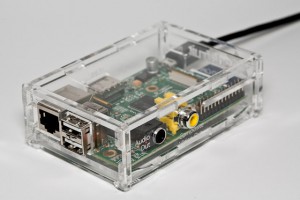 Supplier: PiWorks (via eBay. Other batches are released at this price from their eBay merchant page)
Supplier: PiWorks (via eBay. Other batches are released at this price from their eBay merchant page)
Price: £3
Purchased on: 8th January 2012
Rating: 4/10
This case was part of a batch of 1000 sold at a low price by PiWorks. It is based on the Adafruit PiBox design but is not engraved in any way (the picture above is one I found as I didn’t have my camera available).
 It came disassembled inside a bag (that I had to rip to get all the pieces out) and covered in sticky blue plastic, presumably to protect the pieces from rubbing together and scratching. The first thing I noticed was that, because there was no engraving it was a bit difficult to tell which piece went which way around and which way up. This was solved in a trial-and-error way by holding them against the Pi and playing around until I found the correct way. Then came assembly. Now, I’m not the World’s expert on flat pack furniture and I didn’t expect this to make any difference assembling a Pi case. But, alas, it was a very similar process.
It came disassembled inside a bag (that I had to rip to get all the pieces out) and covered in sticky blue plastic, presumably to protect the pieces from rubbing together and scratching. The first thing I noticed was that, because there was no engraving it was a bit difficult to tell which piece went which way around and which way up. This was solved in a trial-and-error way by holding them against the Pi and playing around until I found the correct way. Then came assembly. Now, I’m not the World’s expert on flat pack furniture and I didn’t expect this to make any difference assembling a Pi case. But, alas, it was a very similar process.
First of all, the instructions supplied by PiWorks are near useless as they don’t tell you which way up to hold the Pi when assembling. In fact, the instructions tell you to assemble the case without the Pi first to get used to how it goes together. The trouble is, once assembled you can’t get the Pi inside so you then have to disassemble it and re-assemble it around the Pi. That aside, the instructions then give you very little help. It’s not that difficult to work out, having said that, but you really need three hands. You sort-of hold ‘this’ bit, press ‘this’ bit up and then snap this other bit on while the whole thing moves and creaks in your hands.
Thus assembled around the Pi, it feels fairly solid. However, it does flex and creak about 1mm around the Pi and I wonder how sturdy it really is. There are numerous warnings in the instructions about treating it carefully and not flexing it too much otherwise bits will start snapping. Not very reassuring. The other major quibble I have is that the instructions say that if you want to plug things into the DSI/CSI sockets, for example, you just take the top off. Wrong. You have to virtually disassemble the case, remove the top and then re-assemble it again. Fortunately, there is a slot for a GPIO cable so most people will be happy.
Having said that, it’s actually quite attractive to look at, being completely clear and it shows off the Pi beautifully.
In conclusion, for £3 it’s not a bad case, but it does have major issues during assembly and is not nearly as flexible in use (in terms of the CSI/DSI connectors) as it is physically (creak creak creak). One more thing, if you use a micro SD card adapter then it’s possible that the adapter will lift the Pi up enough that the HDMI socket goes outside it’s slot.
I wouldn’t recommend it for the kind of price Adafruit charges ($14.95) but as a cheap case, it ain’t bad.
